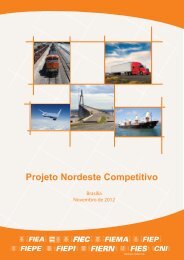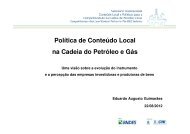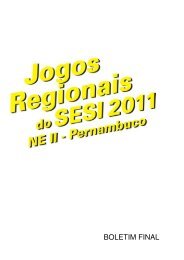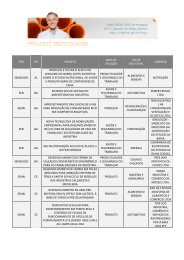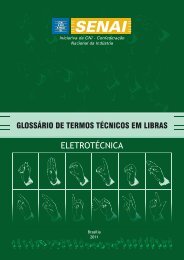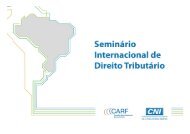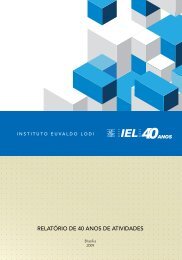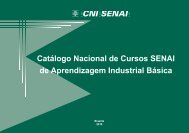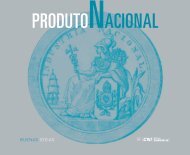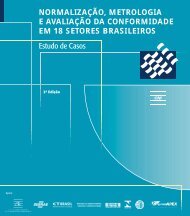A Economia dos Ecossistemas e da Biodiversi - CNI
A Economia dos Ecossistemas e da Biodiversi - CNI
A Economia dos Ecossistemas e da Biodiversi - CNI
- No tags were found...
Create successful ePaper yourself
Turn your PDF publications into a flip-book with our unique Google optimized e-Paper software.
T E E B P A R A O S E T O R D E N E G Ó C I O SNotas de fim1 URL: http://www.scientificamerican.com/article.cfm?id=reclaiming-the-aral-sea (último acesso 1 de abril de 2010).2 Nalwalk, Krilsin (2000) The Aral Sea Crisis: The Intersection ofEconomic Loss and Environmental Degra<strong>da</strong>tion, University ofPittsburgh, Graduate School of Public and International Affairs(25 de abril).3 Micklin, Philip (1988) “Desiccation of the Aral Sea: A WaterManagement Disaster in the Soviet Union” Science, Vol.241:1170-1175 (2 de setembro).4 UNEP (2006) Challenges to International Waters, Global Inter– national Water Assessment, Regional Assessment 24 – AralSea (Fevereiro).5 FAO (1998) Time to save the Aral Sea? Agriculture and ConsumerProtection Department. UN Food and Agriculture Organization:Rome.6 Micklin, P.P. (1992) “The Aral crisis: Introduction to the SpecialIssue” Post-Sov. Geogr. Vol. 33(5):269–83.7 Severskiy, I., Chervanyov, I., Ponamorenko, Y., Novikova, N.M.,Miagkov, S.V., et al. (2005) Global International Waters Assess– ment (GIWA) 24, Aral Sea. University Kalmar, Sweden.8 Micklin, Philip, and Aladin, Nikolay V. (2008) “Reclaiming theAral Sea” Scientific American, (Abril).9 World Bank (2003) Irrigation in Central Asia: Social, Economicand Environmental Considerations. The World Bank: Washington,D.C.10 Spoor, Max, and Krutov, Anatoly (2004) “The ‘Power of Water’in a Divided Central Asia” in Mehdi parvizi Amineh & HenkHouweling (eds.) Central Eurasia in Global Politics: Conflict,Security and Development Brill Academic Publishers: Leiden,Boston, 595.11 Glazovskiy, N.F. (1991) “Ideas on an Escape from the ‘AralCrsis’” Soviet Geography, Vol. 22, No. 2: 73-89 (Fevereiro).12 Glavosky, N.F. (1995) Regions at Risk: Comparison of Threa– tened Environments, The Aral Sea Basin, United NationsUniver – sity Press.13 Temirov, Rustam (2003). “Lobbying Grows in Moscow forSiberia-Uzbekistan Water Scheme” Eurasianet, (19 de fevereiro).14 See: Brander, Luke M., Florax, Raymond J. G. M., and Vermaat,Jan E. (2006) ‘The Empirics of Wetland Valuation: AComprehensive Summary and a Meta-Analysis of the Literature’Environmental & Resource Economics (2006) 33: 223–250 (DÓI10.1007/s10640-005-3104-4); and: Ghermandi, Andrea, vanden Bergh, Jeroen C.J.M., Brander, Luke M., de Groot, HenriL.F., and Nunes, Paulo A.L.D. (2009) The Values of Natural andConstructed Wetlands: A Meta-analysis, Tinbergen InstituteDiscussion Paper TI 2009-080/3 (available at: http://ssrn.com/abstract=1474751).15 Brander, Luke (2010) Personal Communication, Institute forEnvironmental Studies, VU University Amster<strong>da</strong>m.16 Kijne, J.W. (2005) Aral Sea Basin Initiative: Towards a strategyfor sustainable irrigated agriculture with feasible investment indrainage. Synthesis report, FAO: Rome (Junho).17 Chapagain, A.K., Hoekstra, A.Y., Savenije, H.H.G. and Gautam,R. (2006) “The water footprint of cotton consumption:An assessment of the impact of worldwide consumption ofcotton products on the water resources in the cotton producingcountries” Ecological Economics 60(1): 186-203 (http://www.waterfootprint.org/Reports/Chapagain_et_al_2006_cotton.pdf).18 USDA (2008) Cotton: Production, Supply and Distribution,Foreign Agricultural Service, United States Department ofAgriculture: Washington, D.C.19 Environmental Justice Foun<strong>da</strong>tion (2005) White Gold: the truecost of cotton.20 Salim, E., and Ullsten, O. (1999) Our Forests Our Future.Cambridge University Press, Cambridge, UK.21 CNFCM 2000. Center for Natural Forest Conservation Management,Unpublished report to The World Bank.22 Xhao, Guang and Shao, Guofan (2002) “Logging Restrictionsin China: A Turning Point for Forest Sustainability” Journal ofForestry, (Junho).23 Zhang, Peichang et al. (2000) “China’s Forest Policy for the21st Century” Science, 288(5474): 2135-2136.24 Cohen, David H. and Vertinsky, Ilan (2002) China’s NaturalForest Protection Program (NFPP): Impact on Trade PoliciesRegarding Wood. Prepared for CIDA with the Research Centerfor Ecological and Environmental Economics, Chinese Academyof Social Sciences, 63 pages.25 CNFCM (2000) op cit.26 Song, Conghe and Zhang, Yuxing (2010) “Forest Cover inChina from 1949 to 2006” Chapter 15 in H. Nagendra and J.Southworth (eds.), Reforesting Landscapes: Linking Patternand Process, Landscape Series 10, Springer.C a p í t u l o 2 ∙ e s t u d o s d e c a s o ∙ pá g i n a 8 2



